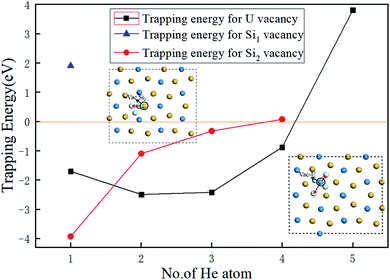 Open Access Article
Open Access ArticleCreative Commons Attribution 3.0 Unported Licence
Correction: Helium-induced damage in U3Si5 by first-principles studies
Yibo Wanga,
Zhenbo Pengb,
Nianxiang Qiu*a,
Heming Hec,
Rongjian Pand,
Lu Wud,
Qing Huanga and
Shiyu Du*a
aEngineering Laboratory of Nuclear Energy Materials, Ningbo Institute of Materials Technology and Engineering, Chinese Academy of Sciences, Ningbo, Zhejiang 315201, P. R. China. E-mail: qiunianxiang@nimte.ac.cn; dushiyu@nimte.ac.cn
bInstitute of Energy Storage & Conversion Technology, Ningbo Polytechnic, China
cSchool of Mechanical and Electrical Engineering, Guangzhou University, Guangzhou 510006, China
dThe First Sub-Institute, Nuclear Power Institute of China, Chengdu, Sichuan 610005, China
First published on 24th August 2021
Abstract
Correction for ‘Helium-induced damage in U3Si5 by first-principles studies’ by Yibo Wang et al., RSC Adv., 2021, 11, 26920–26927. DOI: 10.1039/D1RA04031F.
The authors regret that an incorrect version of Fig. 4 was included in the original article. The correct version of Fig. 4 is presented below.
 | ||
| Fig. 4 The dependence of the trapping energy on the number of He atoms trapped in Vac-U, Vac-Si1, and Vac-Si2 vacancies of U3Si5. | ||
The Royal Society of Chemistry apologises for these errors and any consequent inconvenience to authors and readers.
| This journal is © The Royal Society of Chemistry 2021 |
